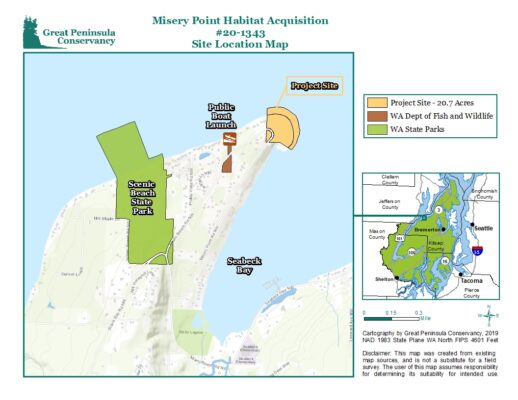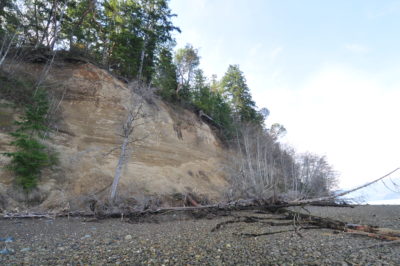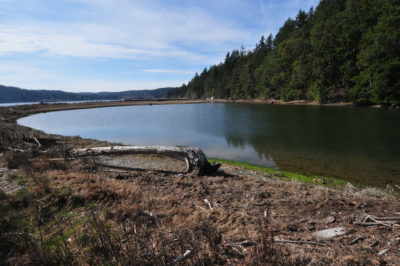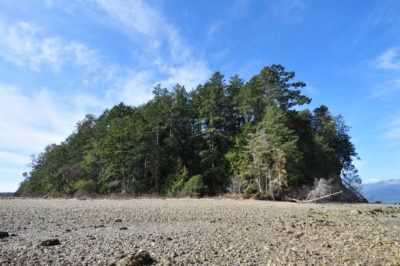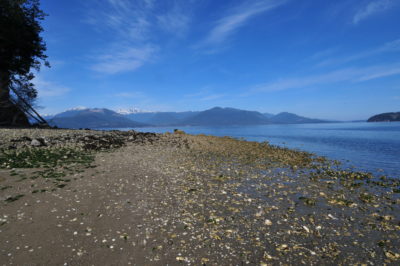Misery Point Preserve
Featured photo: Aerial of Misery Point by Anthony Gibbons.
The Twana name of this point from the Skokomish Tribe is duxʷ’axa∙′dač, meaning the place that is like an arm. “Misery Point” likely took its name from the smallpox epidemic that devastated Native American tribes in the 19th century. While the name remembers a tragic past, today this magnificent saltwater lagoon on the western side of Seabeck Bay is a peaceful oasis for the wildlife and nearby residents that call it home. The local community includes several generations of families that spent decades on this Hood Canal shoreline: crabbing, harvesting shellfish, and creating recreational opportunities at what became the nearby Scenic Beach State Park. The preserve is open for the public to enjoy from dawn until dusk. We ask that visitors please be respectful of the area’s sensitive habitat and our neighbor’s privacy. Please see the “What to Expect” section for more details on accessing the preserve.
Project Details
Despite the development opportunities on this shoreline, the forested point has remained largely untouched for years. Feeder bluffs forge pristine habitat, as do the wetlands and the lagoon’s barrier beach. The eelgrass laden shoreline is an ideal home for forage fish, including surf smelt, sandlance, and herring, which endangered salmon feed upon as they make their seaward journey. With plentiful native flora, Misery Point is home to extensive shellfish, marine life, and birds. The endangered marbled murrelet has even been spotted fishing nearby.
In 2020, GPC was awarded a $1 million National Coastal Wetlands Conservation Grant that was matched with a $600,000 Washington State Salmon Recovery Funding Board grant. The remaining $300,000 necessary to complete the acquisition was provided by the US Department of Defense’s Readiness and Environmental Protection Integration Program. By combining these funding sources, GPC was able to secure this invaluable 20.7-acre property in December 2020.
Featured photo: Aerial of Misery Point by Anthony Gibbons.
The Twana name of this point from the Skokomish Tribe is duxʷ’axa∙′dač, meaning the place that is like an arm. “Misery Point” likely took its name from the smallpox epidemic that devastated Native American tribes in the 19th century. While the name remembers a tragic past, today this magnificent saltwater lagoon on the western side of Seabeck Bay is a peaceful oasis for the wildlife and nearby residents that call it home. The local community includes several generations of families that spent decades on this Hood Canal shoreline: crabbing, harvesting shellfish, and creating recreational opportunities at what became the nearby Scenic Beach State Park. The preserve is open for the public to enjoy from dawn until dusk. We ask that visitors please be respectful of the area’s sensitive habitat and our neighbor’s privacy. Please see the “What to Expect” section for more details on accessing the preserve.
Project Details
Despite the development opportunities on this shoreline, the forested point has remained largely untouched for years. Feeder bluffs forge pristine habitat, as do the wetlands and the lagoon’s barrier beach. The eelgrass laden shoreline is an ideal home for forage fish, including surf smelt, sandlance, and herring, which endangered salmon feed upon as they make their seaward journey. With plentiful native flora, Misery Point is home to extensive shellfish, marine life, and birds. The endangered marbled murrelet has even been spotted fishing nearby.
In 2020, GPC was awarded a $1 million National Coastal Wetlands Conservation Grant that was matched with a $600,000 Washington State Salmon Recovery Funding Board grant. The remaining $300,000 necessary to complete the acquisition was provided by the US Department of Defense’s Readiness and Environmental Protection Integration Program. By combining these funding sources, GPC was able to secure this invaluable 20.7-acre property in December 2020.
Accessibility
Trail Features: Natural surface trails and rocky beach. Also accessible via hand-powered watercraft.
Structures: Interpretive signage.
Parking: Available on nearby road for free or at Boat Launch with a Discovery Pass.
Bathroom: No bathrooms.
Project Partners
National Coastal Wetlands Conservation Grant Program
Washington State Department of Ecology
Washington State Recreation and Conservation Office, Salmon Recovery Funding Board
U.S. Navy REPI Program
Hood Canal Environmental Council
Kitsap Audubon Society

